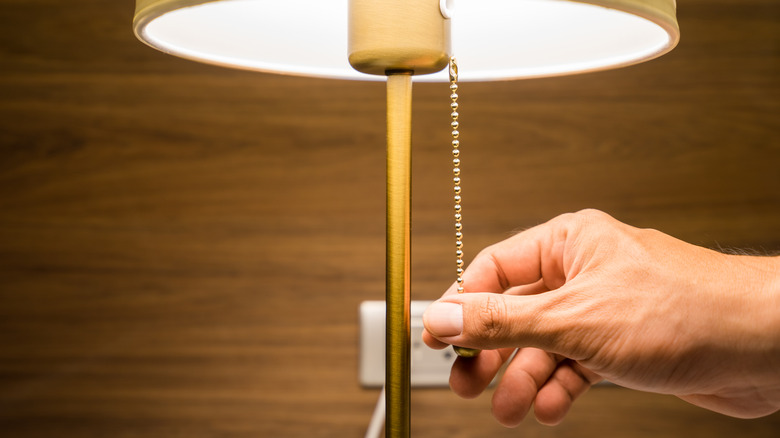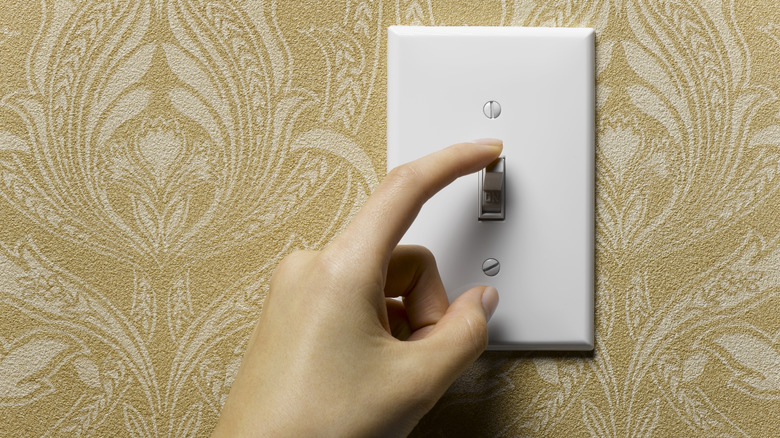An Expert Electrician Explains How To Troubleshoot A Faulty Electrical Outlet
If you've ever plugged an item into the wall and the outlet suddenly sparked, that outlet needs immediate attention. This can be a dangerous situation, and it's best to seek the advice of a professional who knows what to do next. Dan Mock is the Vice President of Operations for Mister Sparky, a business that provides expertise in electrical installation and repair, and he spoke exclusively with House Digest about the question of what to do when an electrical outlet has started to fail.
He begins by describing the signs to watch for that indicate that an outlet has stopped working. "It may be time to repair or replace your home's electrical outlets, or receptacles, if you notice the receptacles are not working as well as they used to or aren't able to hold the plug. Plugs should fit securely in outlet sockets," he explains. If they are starting to fit loosely in the socket, that's a clear indicator that the receptacle is worn out. Mock cautions that continuing to use a worn electrical socket or one that is working intermittently could become dangerous. "If your outlet sparks when plugging or unplugging an appliance, or is discolored or has any black marks, this is considered an electrical emergency and is a sign to install a new one."
Troubleshooting the problem
Mock continues his exclusive interview with House Digest by describing other scenarios that indicate an outlet is in need of attention. "Hot or even warm outlets are extremely dangerous and should be replaced immediately. You should not continue to use these outlets until [they are] repaired." There are major hazards associated with an outlet that's not working properly. "Malfunctioning outlets can be a serious shock and a very dangerous fire hazard," notes Mock. "When repairing or replacing your outlets, it is imperative to call a professional for help."
Although he recommends contacting a professional for major repair work, Mock suggests that there are ways to troubleshoot the problem first. "It is common for homeowners to assume dead electrical outlets can only be fixed by replacement, though typically that is not the case." He goes on to explain different ways to evaluate the receptacle. Get started by taking a small item like a lamp and leaving it in the "on" position. "Plug in the working lamp to the outlet in question. If the lamp illuminates there may have been an issue with other appliances that have been plugged into the outlet. If the lamp remains dark, you've confirmed that there is some kind of issue with the outlet in question."
Searching for clues
The next step involves some investigation but it could save you from calling an electrician when you don't really need one. "Usually, there is at least one outlet in every room that has a dedicated flip-switch on the wall for convenience. Sometimes, there may be more," says Mock. "With the lamp plugged in, try flipping the wall switches in the room." He explains in this exclusive House Digest interview another reason why this research is helpful. "This testing is also an opportunity to determine which switches control which outlets. If the outlets and switches are not set up the way you want them to be, an electrician can safely and easily reconfigure them."
If the outlet is still not functioning at this point, Mock recommends checking for a tripped ground fault circuit interrupter (GFCI) breaker. "GFCI outlets are designed with a built-in breaker to prevent electrocution in the event of a power surge or unsafe outlet use," he explains. "You may be familiar with the two buttons located in the middle of the GFCI breaker. They are different colors and are labeled RESET and TEST. It is easy to check if GFCI outlets have tripped because the button labeled RESET will protrude over the TEST button. You simply need to press the RESET button back down to match the level of the TEST button." He recommends checking all of the GFCI breakers in the home if this doesn't work the first time, even exterior ones.
Calling a professional
If all of these measures have not provided an explanation for why your test lamp isn't turning on, there's one more step that Mock suggests. "If you have access to your breaker panel, this is the last place to safely and easily check for electrical issues before calling an electrician. In the panel you're checking to see if any switches have been tripped, which would eliminate power to a certain portion of your home, including the dead electrical outlets." Once you're looking at your panel, it should be easy to locate any switches that are neither ON nor OFF, but are instead lingering in the space between the two positions. Those are the switches that have been tripped. "To reset a circuit breaker, pull it fully over to the OFF position and then flip it back over to the ON position. If it will not set properly, you may have blown a fuse," says Mock.
Mock emphasizes that it's always appropriate to ask a professional for help, but it's absolutely imperative to let an electrician conduct any necessary repair work. He sums up his exclusive House Digest interview by pointing out, "If after all these checks you still have not solved the problem of your dead electrical outlets, it's time to consult with a licensed professional electrician. When in doubt, have the professionals come out!"



